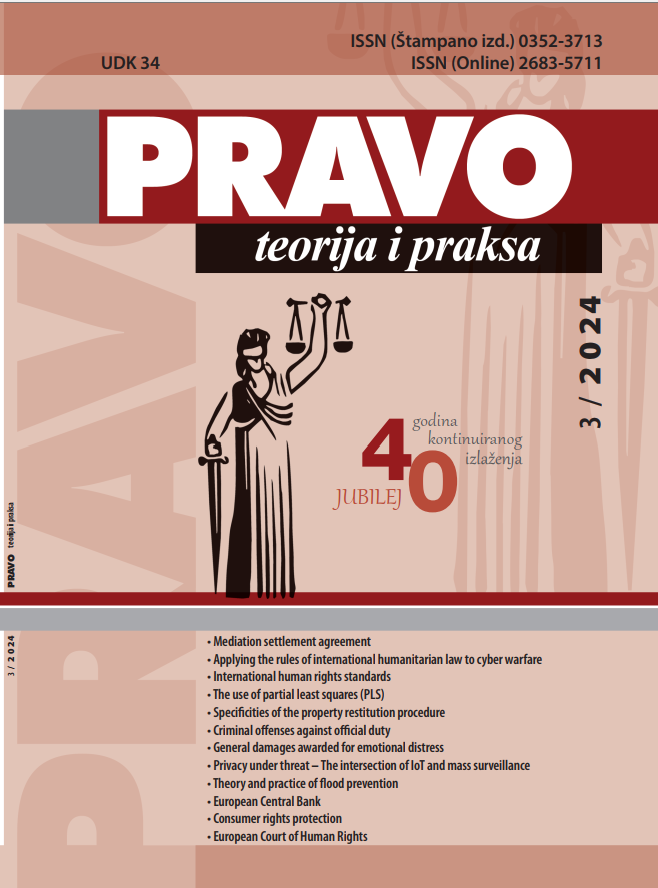Privacy under threat – The intersection of IoT and mass surveillance
DOI:
https://doi.org/10.5937/ptp2403109DKeywords:
Internet of Things, artificial inelligence, privacy, security, personal data collectionAbstract
The rapid development of information and communication technologies, blockchain technologies, artificial intelligence (AI), as well as the Internet of Things (IoT) devices has brought numerous advantages to modern society. Alongside increased comfort of life and efficiency in all areas of human activity, the automation enabled by interconnected networks also poses a challenge to citizens’ right to privacy. The goal of this research is to identify weaknesses in this use of modern technologies, specifically in how they negatively impact the citizens’ right to privacy, by analyzing the relationship between mass surveillance practices and IoT devices. The research established that the implementation of mass surveillance measures using IoT technology can lead to violations of ethical standards, security protocols, and the right to privacy. It has been shown that there are issues with applying existing regulations to IoT and mass surveillance and that no universal legal framework currently exists to protect the right to privacy. The use of IoT technology, especially given the rapid development of artificial intelligence, will in the future raise numerous dilemmas regarding the entities responsible for collecting personal data, the consents required for data usage and processing, where the collected personal data will be used, and for what purposes. Therefore, it is necessary to adapt privacy laws to modern technological advancements such as IoT and AI. This study utilized methods of induction, deduction, and content analysis.
References
Abel, R. (2016). NSA may dabble in IoT surveillance. Downloaded 2024, April 15 from https://www.scmagazine.com/brief/architecture/nsa-may-dabble-in-iot-surveillance
Abendroth, B. (2022). How will government actions on IoT security impact the decisions I make today? Downloaded 2024, May 12 from https://techcommunity.microsoft.com/t5/internet-of-things-blog/how-will-government-actions-on-iot-security-impact-the-decisions/ba-p/3295773
Ackerman, S., & Thielman, S. (2016). US intelligence chief: We might use the internet of things to spy on you. Downloaded 2024, April 15 from https://www.theguardian.com/technology/2016/feb/09/internet-ofthings-smart-home-devices-government-surveillance-james-clapper
Adetunji, J. (2013). Gathering private information online is abuse of state power. Downloaded 2024, April 20 from https://theconversation.com/gathering-private-information-online-is-abuse-of-state-power-15044
Barker, R. (2020). Covid-19 creates numerous use cases for the Internet of Things, but are they legal? Dawnloaded 2024, May 2 from https://www.withersworldwide.com/en-gb/insight/covid-19-creates-numeroususe-cases-for-the-internet-of-things-but-are-they-legal
Domazet, S., & Dinić, S. (2022). International legal aspects of mass surveillance and implications on privacy. Kultura polisa, 19(1), pp. 79– 97, 2022, DOI: 10.51738/Kpolisa2022.19.1r.5dd
Domazet, S., Lubura, M., Šušak-Lozanovska, I., & Ilik, N. (2021). Chinese social credit system: New challenges for the right to privacy? Journal of Liberty and International Affairs, 7(3), 136–148. DOI:10.47305/JLIA21371136d
Domazet, S., & Skakavac, Z. (2018). Skandal ’Cambridge analytica’ – Novi izazov u zaštiti podataka o ličnosti? [Scandal ‘Cambridge analytica’ – A new challenge in the protection of personal data?]. Srpska politička misao, 60(2), pp. 115–133 DOI: https://doi.org/10.22182/spm.6022018.7
Gammeltoft-Hansen, T., & Vedsted-Hansen, J. (Eds.). (2017). Human Rights and the Dark Side of Globalisation. London & New York: Routledge
GAO. (2020). Internet of Things: Information on use by federal agencies. Downloaded 2024, April 15 from https://www.gao.gov/products/gao-20-577
Goodman, M. (2016). Future crimes: Inside the digital underground and the battle for our connected world. London: Transworld
European Parliament. (2023). Resolution on the adequacy of the protection afforded by the EU-US Data Privacy Framework (2023/2501(RSP)). Downloaded 2024, January 5 from https://www.europarl.europa.eu/doceo/document/TA-9-2023-0204_EN.html
Fingas, J. (2018). Beijing uses face-detecting smart locks to curb public housing abuses. Downloaded 2024, May 2 from https://www.engadget.com/2018-12-31-beijing-facial-recognition-public-housing.html
Lau, T. (2019). The government is expanding its social media surveillance capabilities. Downloaded 2024, January 5 from https://www.brennancenter.org/our-work/analysis-opinion/government-expanding-its-social-media-surveillance-capabilities
Marković, D. M. (2019). Totalitarianism as a religious phenomenon. Nauka i društvo, 10(2), pp. 5–20
Marković, D. M., & Dostić, S. (2019). McKinsey 7-S okvir implementacije strategije u oblasti bezbednosti [McKinsey 7-S framework for security strategy implementation] In: Proceedings of the National scientific conference Contemporary Problems and Possible Solutions of Strategy and Strategic Management (SPSSM2019) (pp. 159–176). Beograd: Fakultet za informacione tehnologije i inženjerstvo (FITI); Fakultet za poslovne studije i pravo (FPSP) Univerziteta „UNION – Nikola Tesla“
Matijašević, J. (2013). Krivičnopravna regulativa računarskog kriminaliteta [Criminal law regulation of computer crime]. Novi Sad: Univerzitet Privredna akademija u Novom Sadu, Pravni fakultet za privredu i pravosuđe u Novom Sadu
Matijašević, J., & Ditrih, S. (2021). The impact of the Covid-19 pandemic on health and socio-economic factors in Serbia and the analysis of the legislative response of the state. Pravo – teorija i praksa, 38(2), pp. 17– 30. DOI:10.5937/ptp2102017M
Matijašević, J., & Dragojlović, J. (2021). Metodika otkrivanja krivičnih dela računarskog kriminaliteta [Methodology of detection of computer crime offenses]. Kultura polisa, 18(2), pp. 51–63. DOI:10.51738/Kpolisa2021.18.2p.1.04
Mladenov, M. (2023). Human vs. Artificial intelligence – EU’s legalresponse. Pravo – teorija i praksa, 40(1), pp. 32–43. DOI:10.5937/ptp2300032M
Newman, P. (2019). Chinese officials are using smart devices for surveillance — including connected uniforms to track students. Downloaded 2024, January 6 from https://www.businessinsider.com/chinese-government-smart-device-surveillance-2019-1
Page, C. (2021). Is the UK government’s new IoT cybersecurity bill fit for purpose? Downloaded 2024, April 18 from https://techcrunch.com/2021/12/04/uk-internet-of-things-cybersecurity-bill/
Privacy International. (2020). Mass surveillance Downloaded 2024, April 15 from https://www.privacyinternational.org/learn/mass-surveillance
Satariano, A., Mozur, P., & Krolik, A. (2022). When Nokia pulled out of Russia, a vast surveillance system remained. New York Times [Online]. Downloaded 2024, May 2 from https://www.nytimes.com/2022/03/28/technology/nokia-russia-surveillance-system-sorm.html
Schaer, C. (2023). AI-enhanced identification: A danger in the Middle East? DW [Online]. Downloaded 2024, May 2 from https://www.dw.com/ en/ai-enhanced-identification-a-danger-in-the-middle-east/a-66602156
Skakavac, T. (2020). Uticaj društvenih mreža na pojavu maloletničke delinkvencije [Social networks and juvenile delinquency]. Civitas, 10(1), pp. 72–93
United States Code. (1988). Stored Wire and Electronic Communications and Transactional Records Access, 18 U.S.C. §§ 2701-2711. Downloaded 2024, May 12 from https://www.loc.gov/item/uscode1988-007018121/
Verdict-Encrypt. (n.d.). Edward Snowden: ’The problem isn’t data protection; the problem is data collection’. Downloaded 2024, May 3 from https://verdict-encrypt.nridigital.com/verdict_encrypt_winter19/edward_snowden_data_protection_collection_gdpr
Zirojević, M. & Ivanović, Z. (2021). Cyber law – Serbia. Belgrade: The Institute of Comparative Law
Downloads
Published
How to Cite
Issue
Section
License
Copyright (c) 2024 Siniša Domazet, Darko Marković, Tatjana Skakavac

This work is licensed under a Creative Commons Attribution 4.0 International License.















